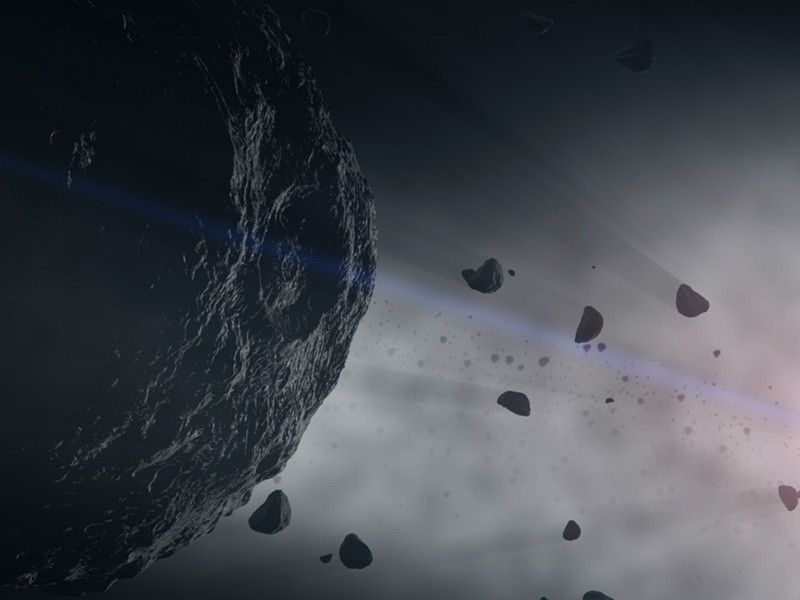Asteroids, Comets & Meteors Facts
At the beginning of our solar system, a huge swirling cloud of dust and gas circled the young Sun. The dust particles in this disk collided with each other and formed into larger bits of rock. This process continued until they reached the size of boulders. This gradual buildup – a process called accretion – eventually formed the planets of our solar system. Billions of small space rocks never evolved into planets. We call these rocks asteroids, comets, and meteors.
Introduction
Many comets, asteroids, and meteors haven't changed much in the 4.6 billion years since they first formed. Their relatively pristine state makes them wonderful storytellers with much to share about conditions in the early solar system. They can reveal secrets about our origins, chronicling the processes and events that led to the birth of our world. They might offer clues about where the water and raw materials that made life possible on Earth came from.
Robotic Exploration
NASA's robotic spacecraft allow us to visit comets and asteroids up close, and even bring back samples to study. We are just beginning to figure out what these places are like, what they are made of, and how they formed.
Raw Materials for Life?
Comets and asteroids probably delivered some of the water and other ingredients that allowed the complex chemistry of life to begin on Earth. The amino acid glycine was discovered in the comet dust returned to Earth by NASA's Stardust mission. Glycine is used by living organisms to make proteins. The discovery supports the theory that some of life's ingredients formed in space and were delivered to Earth long ago by meteorite and comet impacts.
Like forensic detectives, scientists follow clues about what happened when the solar system was young to piece together the story of our origins. What we learn will also teach us about systems of planets around other stars, and how life might develop there as well.
Resources for the Future
We also explore small worlds to understand the hazards and resources in the solar system that will affect human expansion in space. As we venture outward from our home planet, what kinds of challenges will we face?
Might we find new sources of raw materials and natural resources that we could use on Earth? Could humans use asteroids or comets as refueling stations someday? Will we find new, cleaner energy sources in space to help protect our environment?
Protection from Potential Impacts
Asteroid and comet impacts are capable of ending life as well as advancing it. These cosmic collisions are as natural as rain, although they happened a lot more often when the solar system was young. Scientists believe stray objects or fragments from earlier collisions slammed into Earth in the past, playing a major role in the evolution of our planet.
With increasing regularity, scientists are discovering asteroids and comets with unusual orbits, ones that take them close to Earth and the Sun. Very few of these bodies are potential hazards to Earth, but the more we know and understand about them, the better prepared we will be to take appropriate measures if one is heading our way. Knowing the size, shape, mass, composition, and structure of these objects will help determine the best way to divert a space rock found to be on an Earth-threatening path. Missions to comets and asteroids provide valuable information about their composition and structure, helping scientists assess the best methods to deal with those in potentially hazardous orbits.
By immediately tracking potentially hazardous near-Earth objects, or PHAs, we have more time to study potentially threatening situations. NASA's Near Earth Object Program was established in 1998 to coordinate NASA-sponsored efforts to detect, track and characterize potentially hazardous asteroids and comets that could approach the Earth.
To better organize U.S. efforts to track asteroids that might one day threaten Earth, NASA established the Planetary Defense Coordination Office (PDCO) in 2016. The PDCO:
- Provides early detection of potentially hazardous objects (PHOs) – the subset of NEOs whose orbits predict they will come within 5 million miles of Earth’s orbit, and of a size large enough (30 to 50 meters) to cause significant damage on Earth.
- Tracks and characterizes PHOs and issues warnings of the possible effects of potential impacts.
- Studies strategies and technologies for mitigating PHO impacts.
- Plays a lead role in coordinating U.S. government planning for response to an actual impact threat.
To date, NASA-sponsored NEO surveys have provided over 95% of all near-Earth object discoveries.































